2010 Chevy Corvette Grand Sport vs. 2010 Ford Mustang Shelby GT500
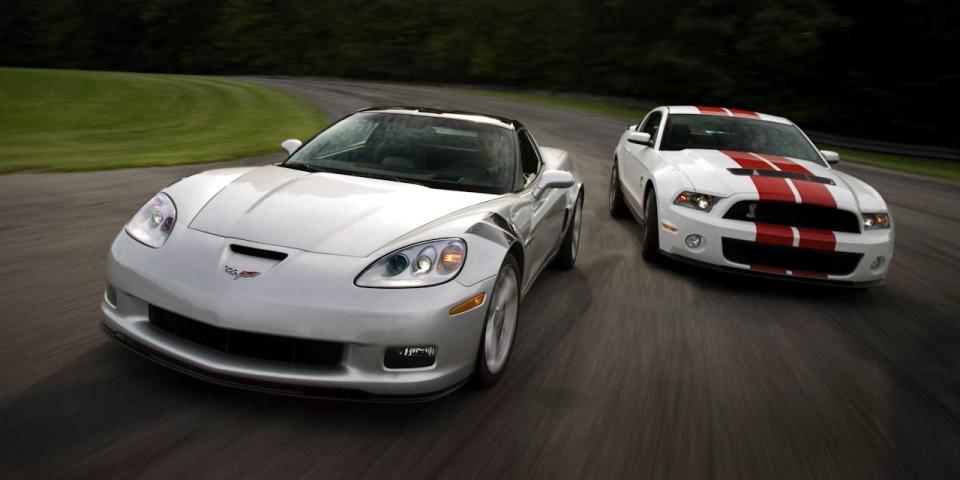


Yes, you’ve seen this movie before. And yes, even with 540 horsepower, to some a Mustang is not, strictly speaking, a sports car. A sports car, by the classic British definition, is one that can, in a pinch, be raced. But times change, and even our resident hotspur Brit, Mr. Gillies, thinks this is talk that predates his birth.
In its most recent encounter with a Corvette—July 2006—the super pony didn’t fare well against Chevy’s shark. Road-course lap times favored the Vette, and even on something as uncomplicated as a drag strip, the big-horsepower Mustang didn’t cover itself with low-ET glory.

So at a glance, this may look like another mismatch. On the other hand, Chevy’s new Camaro inventory has nothing that measures up to this latest Carroll Shelby–anointed Mustang, in either price ($50,895 as tested) or power. (Note: Anointed is not the same as developed. The development was handled by SVT, Ford’s Special Vehicle Team.)
Composed of young engineers dedicated to adding a little glamour and/or haste to various Fords, SVT has teetered on the verge of expendability for years. Nevertheless, even in this age of green priorities and tight money, SVT persists, while GM’s performance group has been disbanded.
SVT has made a number of positive upgrades to the GT500, giving it essentially the same chops, including those 540 horses, as the GT500KR (King of the Road) that ruled the 2009 Mustang family, for far less money. Meanwhile, even though the performance group has been scattered throughout GM’s mainstream gulag, development hasn’t ground to a halt at Corvettestan, where the disciples of Zora Arkus-Duntov have made some revisions for 2010. These include the revival of the Grand Sport name (base price $55,720, $64,815 as tested), a name once confined to racing editions originally created by Saint Zora himself.
So, two perennial rivals—updated for 2010, with a combined engine output of almost 1000 horsepower—meet on bad-boy territory, our favorite automotive turf. Having provided ourselves with an excuse to indulge in kidney-displacing g-loads, we corralled a GT500 and a Grand Sport Vette and headed west for some hasty driving, including an afternoon at Grattan Raceway Park near Grand Rapids, Michigan.
Given the differing character of these two, we also added a nondynamic element, parking this Vette and Mustang amid the eclectic car collection that cruises in every Thursday to the Depot Town district of Ypsilanti, Ann Arbor’s next-door neighbor. In this curbside contest, the GT500 was the winner. As for the rest of the test...
If you’re a member of the SVT group, right about now you’re saying something like, “How am I gonna explain this to Mr. Mulally?” A two-word answer: live axle. If you’d pony up the dough for an independent rear suspension, Mr. Mulally, the Mustang would stand a better chance of running with the best.
Still, Ford makes the live axle work in lesser Mustangs, most recently winning a three-way pony-car tournament [“All-Beef Sliders,” July 2009]. But how much better it would be if the two halves of the retuned rear suspension weren’t fastened to that big cast-iron log.
A solid rear axle creates ride and handling challenges for the suspension team. That’s why live-axle suspension systems have all but disappeared from passenger cars—except certain Fords. This is hard to justify in a car with serious performance aspirations and a hefty price tag.
Heft is another area of GT500 suffering. At 3897 pounds, it’s a hernia-inducing 559 pounds more than the Grand Sport and more than 300 pounds porkier than the Mustang GT, all of which reside over the front axle, creating an almost front-wheel-drive weight distribution—57.4 percent front, 42.6 percent rear. Mass, plus solid rear axle, plus skinnier tires (like the Vette, the Mustang wears Goodyear Eagle F1 Supercars but with smaller footprints) held the GT500 back in every aspect of our instrumented testing.
Ford forecasts runs to 60 mph in 4.3 seconds. But even though it enjoys a power-to-weight advantage versus the Vette, in four tests with four different GT500s the best we’ve achieved is with this example: 4.5 to 60 and the quarter in 12.7 at 115 mph.
There’s certainly no shortage of thrust. The GT500’s supercharged and intercooled 5.4-liter V-8 delivers potent midrange response and sounds terrific, a wolf growling through the street-traffic sheep. But all that power makes it tough to keep launches from going up in smoke.
____________________________________________________
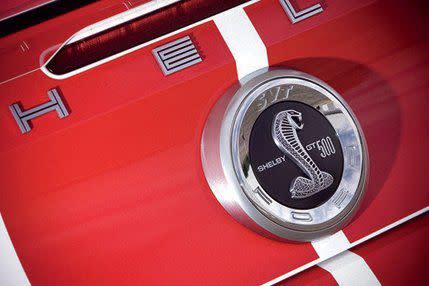
Big forward weight bias held the Mustang back on the road circuit, but the combination of mass up front and 540 horsepower going to the rear tires makes it a drifter’s dream.
____________________________________________________
We were surprised to find that the Mustang’s muscle was tractable on the road course. We were also surprised at its balance. Understeer still dominates, but the senior Stang can be pitched into corners, its recovery in quick transients is prompt, and its steering is quick (2.7 turns) and communicative. Grip (0.91 g) is respectable, although it’s hard to keep the inside rear tire from smoking out of hard corners, limited-slip diff notwithstanding.
The Mustang was fast down Grattan’s long front straight—136 mph before the Turn One braking zone—but it was still 3.1 seconds slower around the 2.0-mile circuit.
Away from the track, the Mustang is more likable. We gave it a small edge in ride quality (though this is like the difference between flint and granite—both are hard). The quality of the paint, assembly, and interior materials is consistent with the big price tag—not a squeak or a rattle with 6400 miles on the odo—and if the seats aren’t as supportive as those in the Vette, they look snappy with their red-and-black color scheme. We gave a clarity advantage to the GT500’s nav system, and, of course, the Mustang has a back seat—extra points for that. We’d like the front buckets better if the seatbacks were power adjustable, and we’d like the Alcantara-clad steering wheel better if it adjusted for reach as well as rake—not an unreasonable expectation in a $50K car.
Still, no one was surprised that the Corvette took the trophy again. In part, this is due to the difference between a sporty car and a true sports car. But it’s also due to the Ford’s archaic rear suspension. The SVT troops have done a remarkable job of keeping it viable, but it’s like prepping for a hundred-meter sprint by connecting your ankles with a three-foot tether. Adding power can’t completely fix it.
Few cars have had a development history as long as the Corvette’s, and fewer still—if any—have been developed so successfully. We’ve been using the term “world-class sports car” to describe Corvettes since the introduction of the C4 for 1984, and it becomes increasingly valid with every engineering tweak and upgrade, improvements by competitors notwithstanding.
____________________________________________________
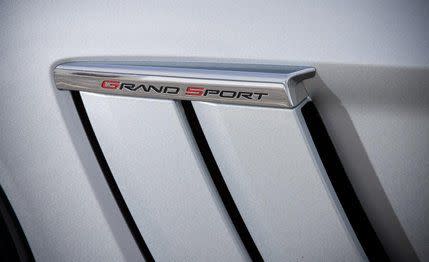
____________________________________________________
The Grand Sport represents the most extensive update to the Corvette lineup for 2010, replacing the former Z51 package designation but preserving its gearing and stiffer suspension tuning. Added items are the wider Z06 body shell with a slightly taller rear spoiler, integrated rear brake ducting, Z06 brake hardware, and rear fender flares embracing wider rubber. Manual-transmission Grand Sport coupes also get a dry-sump oil system that’s shared with the Z06 and ZR1, and the new designation slots in just below the hottest models in the Corvette pecking order
With its specific aluminum-alloy wheels wearing fat Goodyear Eagle F1 Supercar tires at both ends—275/35ZR-18 front, 325/30ZR-19 rear—the Vette pulled a resounding 1.02 g on the skidpad, completely upstaging the GT500.
____________________________________________________
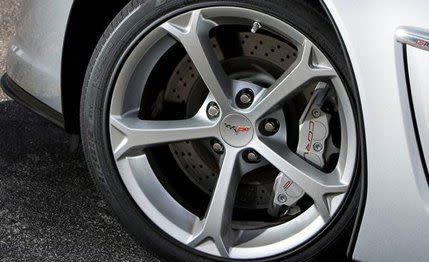
____________________________________________________
This was also true of the Vette’s braking performance—70 mph to 0 in just 147 feet, with seemingly infinite repeatability, something that wasn’t true of the Mustang. The Vette also held the edge in acceleration—0 to 60 in 4.1 seconds, the quarter in 12.5 at 116 mph—and its best timed lap at Grattan was 1:30.2. All these objective results were better than those recorded in our 2006 comparo.
After Grattan, one tester observed that, “assessed as a road-circuit weapon, the Corvette is a precise dueling instrument, like an epee; the Shelby is more like a bludgeon.”
The Corvette team can also brag that it achieves this formidable performance without paying gas-guzzler duty. The EPA projects fuel economy of 16 mpg city and 26 highway for the Grand Sport. We recorded 21 mpg during our test. The GT500 is rated for 14 mpg city and 22 highway, an improvement over its predecessor, but there’s still a guzzler fee ($1000), and our test average came in at 18 mpg. There were demerits. Though the Corvette got the edge in driver comfort, the Mustang is easier to get in and out of, and the quality of its interior materials—dashboard and door panels—is distinctly higher than those used in the Vette. And as with the Mustang, we’re disappointed at the absence of a power seatback adjustment in a car costing as much as this.
____________________________________________________
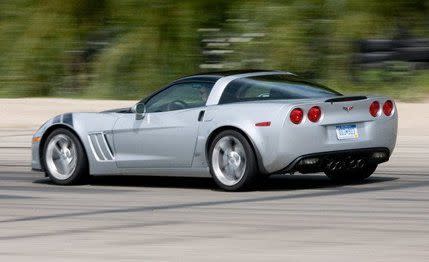
____________________________________________________
On the other hand, the Grand Sport’s steering wheel is adjustable for both rake and reach, with an optional power switch for the telescope function. And the seats are improved over the ones we called “inferior” in our 2006 test—though we’re still put off by the way the unoccupied passenger seat flops forward during hard braking.
A more significant complaint was that the Grand Sport’s behavior on fast corners afflicted with sharp bumps and/or broken pavement became lively to excess, provoking little directional adjustments that the driver hadn’t programmed. Although the Vette’s massive grip and quick steering (2.5 turns lock-to-lock) made it easy to restore the car to the intended line, this nervous kind of behavior is not endearing, particularly at higher speeds.
The pavement at Grattan was smooth, but in this venue, the Grand Sport’s neutral handling and favorable weight distribution (50.6 percent front, 49.4 percent rear) made corner exits tricky—an injudicious stab at the throttle could easily provoke oversteer.
Stiff suspension tuning contributes to the foregoing, of course, and it also gives the Grand Sport ride quality that’s abrupt—no expansion joint or tar strip is beneath its notice.
But these are the dynamic traits we associate with cars that “can, in a pinch, be raced.” Sports cars. Considered in terms of that vehicle category, “world-class” applies now more than ever.
You Might Also Like

 Yahoo Autos
Yahoo Autos 